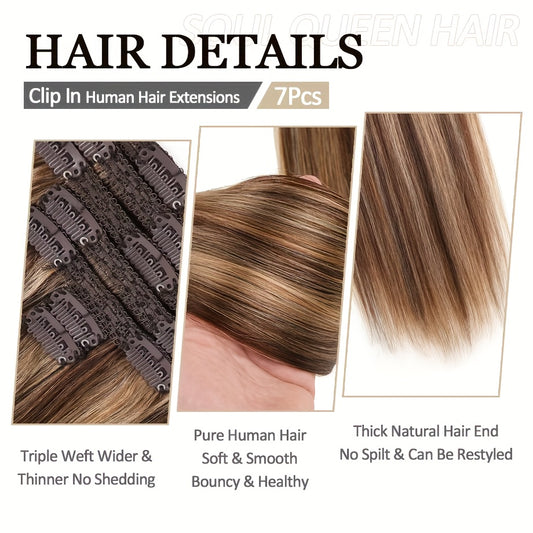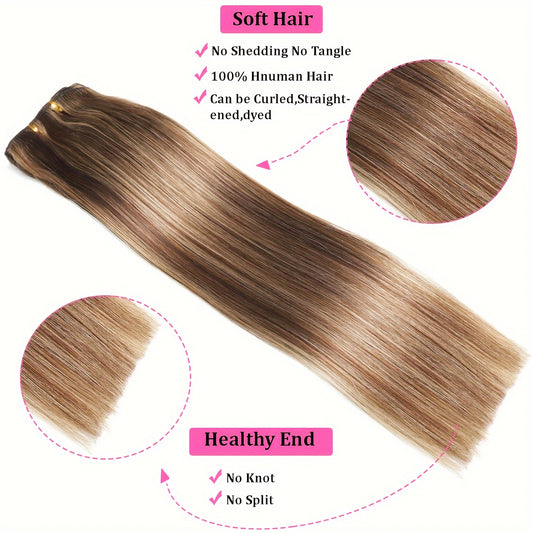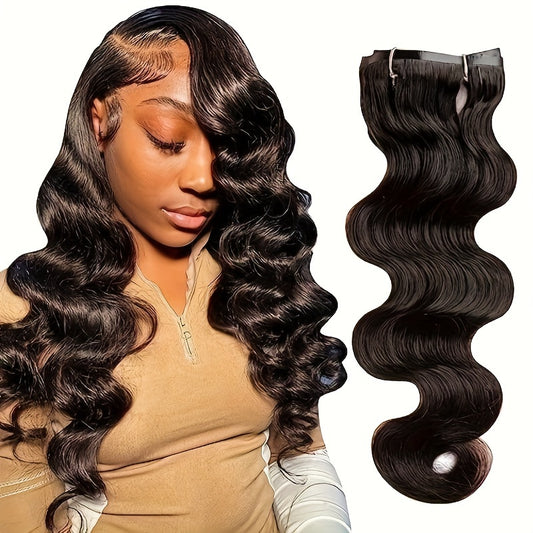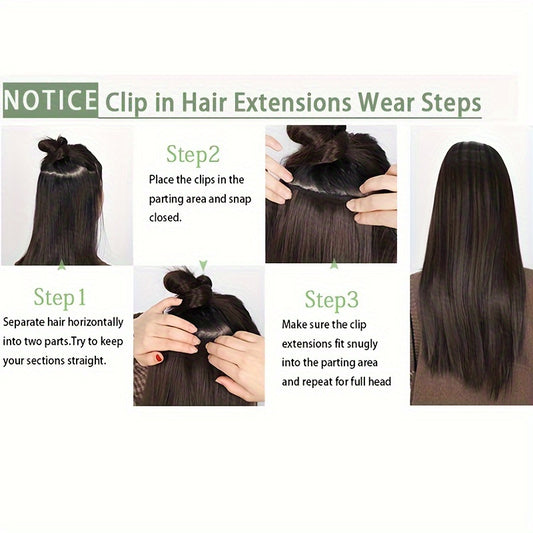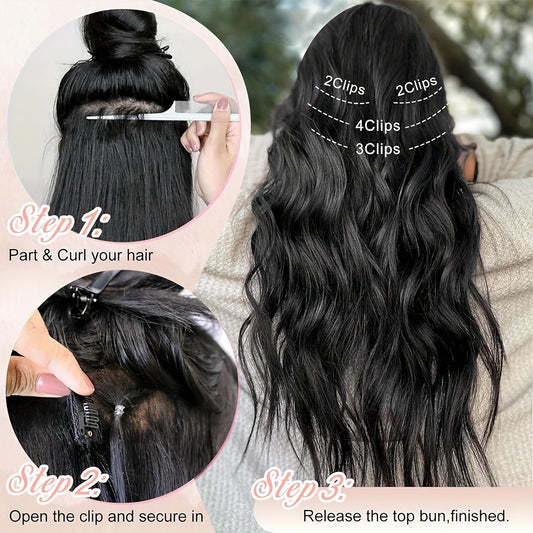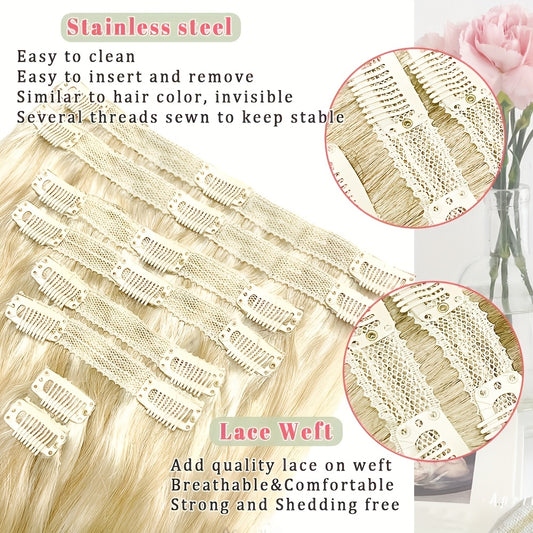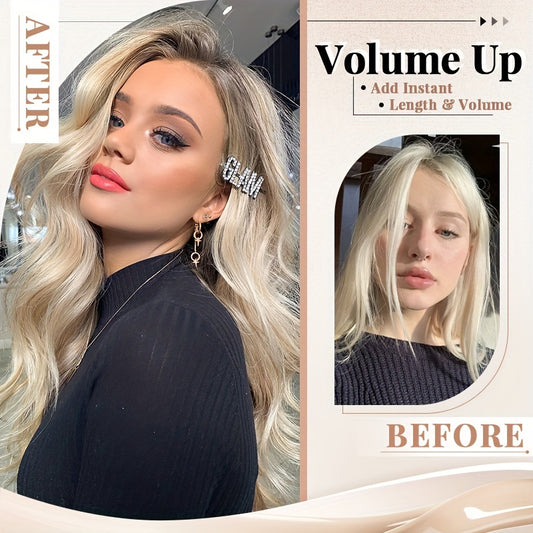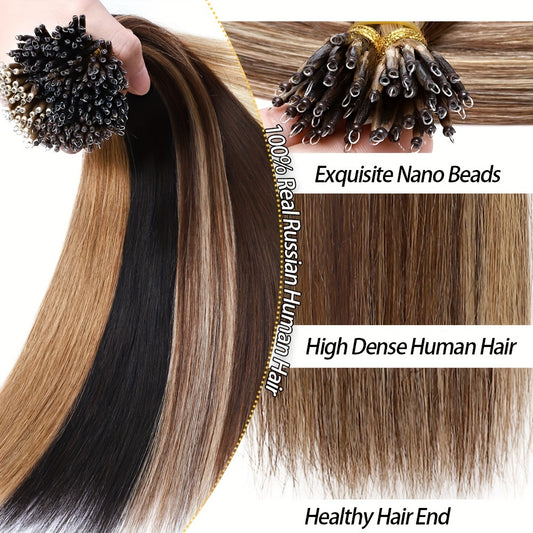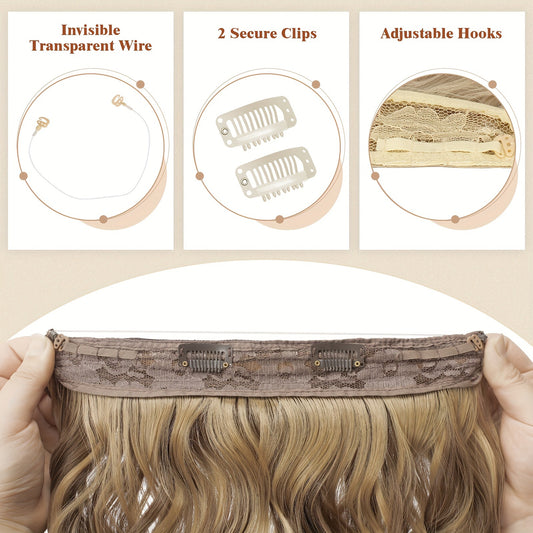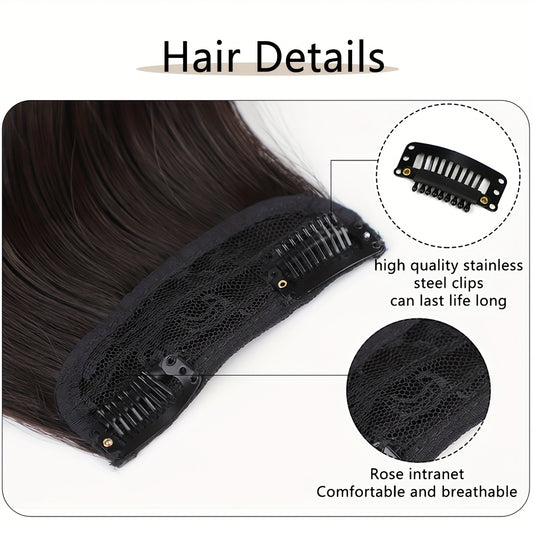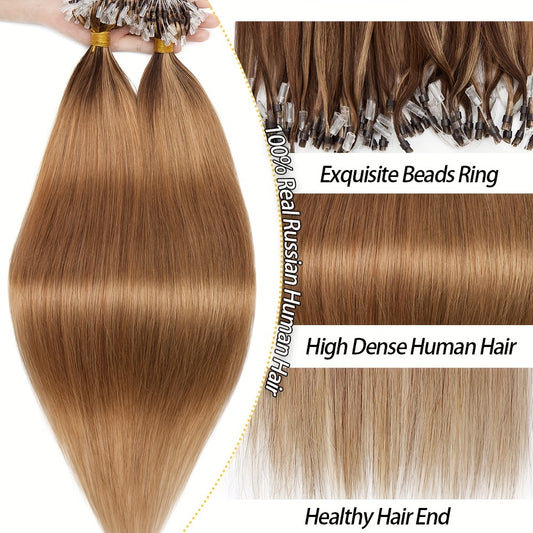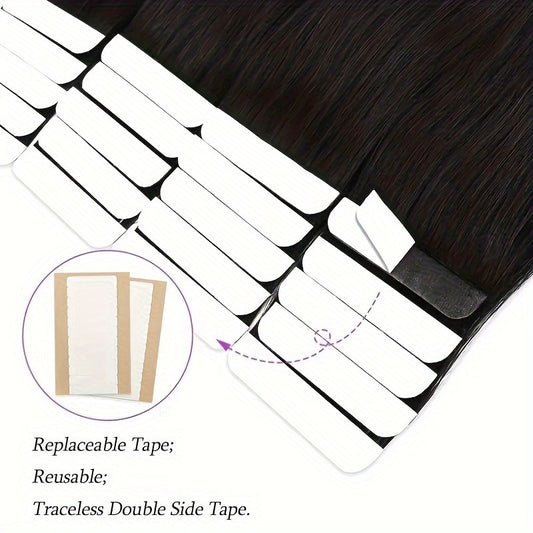About 18 Inch Hair Extensions
What 18 inches means on the body
On an average-height person, 18 inches usually lands around mid chest when straight and about a notch higher when waved. Petite wearers may see the ends sit a little higher. Taller wearers may see the ends a little lower. Jackets, scarves, and bag straps touch the hair more often at this length than at 14 to 16 inches. A light brush after removing outer layers keeps the ends tidy. A small drop of serum on the mid lengths and ends controls static and reduces snags. Keep product off the roots so clips hold cleanly.
If you often wear tight curls, remember that curls compress visible length. The hair will look shorter than the measured length because curls stack and lift the ends upward. If you prefer a sleek finish or soft waves, the hair will appear closer to the full 18-inch measure. These are normal behaviors and they help you plan styling and grams selection.
Who benefits most from this length
Wearers with shoulder-length hair who want a noticeable step up in length and a stronger outline benefit the most. Fine and medium strands gain stability because extra hair supports curls and blowouts. People who present on camera or record content like the clean bottom line that 18 inches can show in photos. Event guests and brides enjoy the reach of this length for half ups, low buns, and brushed wave looks. Travelers can still pack and store this length easily with a satin pouch and a loop brush.
If your natural hair is very short, covering clips may be hard. Waiting for more growth or using a halo system can be a better start. If your natural hair is very dense, you may need more grams to keep the ends looking full in straight styles. The aim is match and balance, not just length.
How to choose grams
Grams describe how much hair is in the set. More grams equal more density and a thicker edge. Less grams equal lighter wear and a softer edge. Simple guidance works well. For subtle fullness and a gentle length boost on layered cuts, choose around ninety to one hundred twenty grams. For an everyday full look that photographs well but still feels light, choose around one hundred thirty to one hundred sixty grams. For blunt cuts, thicker strands, or glam wave styles that must last under lights, choose around one hundred seventy to two hundred twenty grams.
If your haircut is blunt and the ends form a straight line, you often need more grams so the extension hair can meet that line without a shelf. If your hair has layers, you can use fewer grams because layers hide the join points naturally. It helps to think about how the bottom edge will look in a straight photo. A clear, confident line needs enough mass to stay smooth.
End fullness and draw
Draw describes how thick the ends look. Single drawn hair is thinner at the tips and thicker near the top, like natural hair that tapers softly. Double drawn hair keeps more thickness near the ends for a neat, sharp edge. If you love soft movement and easy brushing, single drawn feels very natural. If you want the ends to look polished and strong in straight styles, double drawn is the right choice. Both are valid. Pick based on how you wear your hair most days.
If you only have access to one draw option, you can still fine tune the look. A small trim of half an inch to one inch by a stylist can square the edge and make the perimeter look richer. The trim does not erase the length. It simply makes the bottom line look finished.
Texture choices in plain words
Straight texture gives a sleek, glassy finish and a very clear outline. Body wave is the easiest to blend with most hair and can be brushed straighter with one low-heat pass or curled into a fuller wave. Curly and coily textures should match the curl diameter of your own hair so the coils stack cleanly. Choosing by curl size, not just by a label, makes blending faster. At 18 inches, body wave is a popular base because it lifts the ends slightly and reduces the heat needed for hold.
You do not have to fight your base texture. Instead, choose a base that supports how you style most of the time. If you wear a blowout often, straight is fine. If you switch between soft bends and loose curls, body wave is flexible. If you wear defined curls or coils, choose a pattern close to yours so the join line disappears.
Color matching made easy
Match color by undertone first and depth second. Undertone can be cool, neutral, or warm. Depth is how light or dark the shade is. Check color in daylight near a window. Bathroom lighting often pushes yellow or blue and can mislead your eye. If you are between two shades, choosing the slightly lighter one is safer. Remy human hair can be toned a bit darker or cooler. Lifting hair lighter can hurt the cuticle and shorten the life of the extension.
If your roots are deeper than your mid lengths, a rooted or balayage option hides seams at the part and the temples. This is useful when you part your hair on camera or outside in bright light. Take a quick daylight photo of your match and keep it for reorders. This simple step keeps expectations steady across seasons and rooms.
Why remy human hair matters
Remy hair keeps the cuticles aligned in the same direction. That lowers friction, so tangles are fewer and brushing is smoother. The hair moves like your own and shines softly, not like plastic. You can style with moderate heat and get reliable results. A single slow pass to straighten is better than several quick hot passes. You can wash gently when needed and air dry the wefts on a hanger. If you want to tone the color slightly cooler or darker, Remy hair accepts that change without harsh steps.
Over time, these traits protect the ends. They also make the hair photograph better at 18 inches where the hem shows in most frames. The difference is not just comfort. It is how long the set stays looking good.
Clip-in method in simple steps
Clip-ins are the easiest way to use 18-inch hair on demand. They take a few minutes to put in and a few seconds to remove. The basic map is always the same. Place the widest weft above the nape for the anchor. Place medium wefts higher around the back of the head to build body. Place narrow wefts near the sides to fill the temples and shape the face frame. Leave enough natural hair on top to cover the clips even if the wind moves your hair.
To make clips hold well, tease the roots lightly where the clips will sit and mist a small amount of flexible hairspray for grip. Keep oils and heavy creams off the roots. Clip the center of a weft first so it sits flat. Then close the side clips. Space each row about a finger to an inch above the last. This rhythm keeps the wefts even and comfortable.
How to blend after installing
For waves, curl the back pieces in alternating directions and curl away from the face in front. Let all curls cool fully before brushing. Cooling is what locks the shape. Brush gently to create one smooth pattern. For straight looks, use a heat protectant and keep tools under one hundred eighty degrees Celsius or three hundred fifty degrees Fahrenheit. One slow pass is enough for most hair. Finish with a tiny drop of serum on the mid lengths and ends only.
If a line shows, move your part a little or add a slim cover weft one row higher. Always leave a generous top layer over the clips. If the ends look too soft for your taste, ask a stylist for a half inch trim to square the edge. These small changes often make the entire style look cleaner.
Everyday styles that work well
Clean center part with a beveled blowout that shows a straight but gentle curve at the ends. Deep side part for quick crown lift and an elegant angle on one side. Loose barrel waves brushed into a smooth S pattern for a polished look. Pinned back sides with small clips to hold flyaways without hiding the length. Two tiny braids at the temples to add texture near the face without clutter. Compact claw clip twist that sits low and neat for commuting and meetings. Sleek low pony at the nape with a wrapped section for a tidy finish.
These styles protect the illusion and are fast to repeat. They also work with jackets and scarves. At 18 inches, keeping the ends calm and consistent is what reads as high quality on camera.
Care routine in short steps
Brush before and after each wear with a loop brush or a wide tooth comb. Support the weft with your other hand so you do not pull at the seam. Wash clip-ins every ten to fifteen wears or when you feel product build up. Shampoo your natural hair and let the suds run through the wefts. Condition only from mid length to ends. Rinse cool to close the cuticles. Blot with a microfiber towel. Air dry the wefts on a hanger when possible.
Use heat protectant every time you style. Keep hot tools at or under the stated limit. Store the wefts brushed, coiled in a gentle U shape, and placed in a satin pouch away from heat and moisture. Do not sleep in clip-ins. Rotate clip positions slightly so the same root spots do not carry all the weight every time.
Fast fixes for common issues
If a weft shows in bright light or wind, shift your part a small amount or add a slim cover weft one row higher. If the ends look thin in straight photos, trim half an inch to one inch or choose double drawn next time. If tangles form at the nape under coats or straps, hydrate the ends, use less heat for a few days, and brush right after you take off outer layers. If clips slide on fine hair, clean the clip teeth, add a light texture spray to the roots, and avoid placing clips on freshly conditioned sections.
If the color looks close but not perfect, tone a bit darker or cooler. If your roots are darker, choose rooted or balayage to blur the seam. If your scalp feels tender, move clips a little, use fewer pieces for daily wear, and give your roots rest days. These changes are small and they work quickly.
Workout and travel notes
Remove clip-ins for high intensity workouts. That one minute prevents root strain and saves more time later. For light sessions, use a low braid and a soft headband. Brush only when hair is cool and dry. On flights, cabin air is dry. Smooth a tiny drop of serum on the ends and store the hair in a satin pouch. After landing, mist a leave in spray and brush gently. For destination events, set curls, let them cool fully, brush to merge, and spray the brush with flexible hold before one final sweep.
Pack a small kit: loop brush, satin pouch, travel size serum, and two spare clips. This kit solves almost all on the go issues without heavy products.
Quality signals to look for
Look for one hundred percent Remy human hair with aligned cuticles. Ask for clear daylight photos of each shade. Check that stitching along the weft is even and tight. Squeeze each clip to see if the spring feels strong and returns to position. Confirm that the silicone sleeves on the clip teeth are smooth and uniform. Ask if the grams number is measured after the hair is sewn to the weft. Post weft grams are the honest figure.
Quality brands also publish simple education: a grams guide, a short install video, and a small care card. Honest claims and clear instructions show respect for your time and your investment.
Page layout that helps buyers
A helpful product page starts with the exact length and method in the title so searchers know they are in the right place. The first photo should show the same shade in daylight from front, side, and back. A close crop of the ends proves density. A short line under the photos states where the hair lands on the body and how long the install takes. Filters for grams, texture, and shade family let buyers find a match fast. Each product tile should list grams and texture, plus a small tag like everyday density or blunt cut ready.
A small how to apply block with a three step diagram builds confidence. An FAQ answers heat limits, wash cadence, and return basics. A note near the color swatches reminds buyers to match undertone in daylight. These small elements do more than long paragraphs because they appear right where the decision happens.
Simple measurement tips
Stand straight and place a soft tape behind the ear. Measure down to the point on your chest where you want the ends to fall. That is your straight finish target. Subtract about one inch if you plan to wear waves most days. Subtract more if you wear tight curls. Try a test with your favorite neckline or blazer so you can judge proportion. Many people like how 18 inches frames a blazer lapel or an open collar.
Take one daylight photo of your current hair and one of the test length. Save them for reference. This makes reordering and color matching easier later.
Comfort and safety basics
Clips should hold without painful pressure. If you feel pulling, reset the section, tease lightly, and shift clip position. Do not sleep in clip-ins. Keep heavy oils off the roots. Place serums only on the mid lengths and ends. Rotate exact clip positions a little each time. If your scalp is sensitive, wear fewer pieces for everyday and add two more for events. Being gentle is not a weakness. It keeps your hair and the extension hair in better shape for longer.
If you have a scalp or skin condition, talk with a professional before using any attachment method. Clip-ins are cosmetic accessories. They are not medical tools. Respect heat limits and be careful with any color change. Tone slowly and test on a small piece first.
Quick style menu
Tidy center part and clean blowout for daily polish. Side part with a quick ear tuck for instant lift. Brushed wave sheet for photos and events. Minimalist pinned sides to keep flyaways out of the face. Low pony with a wrapped strand for a sleek line. Compact claw clip twist on busy days. Two narrow temple braids if you want a touch of texture near the face. These are repeatable and resist wind and movement when done with a generous top layer.
Keep a simple plan. One daily style you can do in five to ten minutes. One event style that feels special but simple. Repeat them. Consistency is what makes hair look expensive in pictures.
Light language faq
Will 18 inches feel heavy? With the right grams it should feel secure but not heavy. Where will it land? On most people it lands at mid chest when straight. Can I use heat? Yes, with protectant and moderate settings. How often should I wash clip-ins? Usually after ten to fifteen wears. Can I dye them lighter? Lifting is not advised. Toning darker or cooler is safer. Can I sleep in them? No, remove clip-ins before bed. What if my roots are darker? Choose rooted or balayage options to hide seams. What if clips slip? Clean clip teeth, tease lightly, and avoid fresh conditioner at the roots.
How long will they last? With careful use, many months. How do I hide a blunt line? Use enough grams, place a slim cover weft higher, and consider a small trim for a firm edge.
Short checklist before buying
Confirm your current length and the target landing point on your body. Decide how much volume you want at the ends. Choose grams based on your haircut type. Pick a texture that matches your daily habit. Match color undertone in daylight and decide on rooted or not. Plan two default styles. Assemble a small kit with a loop brush, a teasing comb, a heat protectant, a flexible spray, and a satin pouch. Make a quick note of your shade code and tool settings so you can repeat success later.
This checklist turns an idea into a plan. A plan makes the result easier and more reliable.
Store and travel setup
Keep the set in a satin pouch or a box in a cool, dry drawer. Do not place the pouch near heaters, windows with strong sun, or showers with steam. When you pack for travel, coil the wefts in a gentle U so the clips do not press into the hair. Carry a small brush, a few bobby pins, two spare clips, and your protectant. On arrival, hang the wefts for a few minutes to relax any bends from packing. Brush once and they are ready to use.
If you plan to swim, remove the clip-ins first. If you are at the beach all day, a simple low braid in your natural hair and a wide hat protect roots and keep your scalp calm. Put the extensions back in for dinner in a few minutes.
Simple photo tips for color
Stand near a window with daylight. Hold the weft next to the mid lengths and ends of your own hair, not the roots. Take a clear photo without filters. If your camera lets you set white balance, choose daylight. If not, do not worry. The window light will be close. Take one photo from the side and one from the back. Save them with the shade name. You now have a record that you can trust for reorders or small toner adjustments later.
If you notice that indoor lights make the color look warmer, trust the daylight view. Indoor bulbs vary. Your eyes will see different tones under different lights. Daylight is the standard for color decisions.
What not to do
Do not place clips on wet or oily hair. Do not set heat tools above the recommended limit. Do not make many quick hot passes; one slow pass gives more polish and less damage. Do not sleep in clip-ins. Do not apply heavy oils at the roots. Do not try to lift the color lighter. Do not stack too many pieces near the crown where the top layer is thin. These mistakes create problems that are easy to avoid with a few calm habits.
If a step feels difficult, stop and reset. The method is simple when you move slowly. Section, anchor, blend. That rhythm works every time.
Edge cases to consider
If your natural hair is shorter than the jawline, coverage is hard and the top layer may not hide clips. A halo system or waiting for more growth is wiser. If your natural hair is very thick and coarse, a standard set may not be enough for straight finishes; you may need more grams or a professional method. If you need very high ponytails or top knots daily, clip-ins will show unless mapped with advanced technique. Low buns, half ups, and down styles are the best use cases for concealment.
If you have a sensitive scalp or a skin condition, use fewer pieces, move clips daily, and speak with a professional if any area feels sore. Comfort is a requirement, not a bonus.
Simple terms glossary
Grams means the weight of the hair in the set. Draw means how full the ends look. Single drawn is softer at the ends. Double drawn stays full to the ends. Occipital is the back curve of the head where medium wefts sit. Rooted means the top of the hair is slightly darker. Balayage means blended lightness from top to bottom. Cover weft is a slim piece placed higher to hide any seam. Perimeter means the visible edge of the hair when you look at it from the back or the side.
These terms are enough to make clear choices without guessing. If a term is not helpful, ignore it and focus on the photos and the simple steps above.
Simple summary
Eighteen inches is a true long length that still behaves well. It lands around mid chest on most people and can be styled quickly with a few calm habits. Choose grams to match your haircut so the ends look deliberate. Pick a texture that supports your daily routine. Match color by undertone in daylight. Install with a simple map. Blend with cooling and one gentle brush out. Care with light hands and store in satin. These steps are short, repeatable, and enough to get a result that looks like your hair on its best day, only longer.
If you ever feel unsure, return to the basics. Section, anchor, blend. Use the daylight check. Keep heat moderate. Support the weft with your hand when brushing. Small, steady actions beat complicated routines.
Customer reviews
- I went with a 150 g 18-inch set after the simple grams guide and my straight styles finally look full without feeling heavy; curls last all day when I let them cool before brushing. — Hannah Reid, Glasgow, United Kingdom ⭐⭐⭐⭐⭐
- The daylight color tip helped me pick a neutral shade with a soft root; outdoors and on camera it blends perfectly, and the install takes me under six minutes now. — Camila Torres, Bogotá, Colombia ⭐⭐⭐⭐⭐
- I have a sensitive scalp and these still feel fine; a little teasing and a touch of texture spray keep the clips steady from the commute to dinner. — Noor Rahman, Abu Dhabi, United Arab Emirates ⭐⭐⭐⭐
- I chose body wave because I switch between blowouts and loose curls; the ends sit just right at mid chest and the edge looks clean in photos. — Elise Moreau, Lyon, France ⭐⭐⭐⭐⭐
- Two narrow side pieces fixed the hollow near my temples and the half inch trim suggestion made the edge look like a salon cut at this length. — Amahle Ndlovu, Durban, South Africa ⭐⭐⭐⭐⭐
- I teach online and the 18-inch outline reads polished on screen; no plastic shine and very little brushing needed during breaks. — Jordan Miller, Seattle, USA ⭐⭐⭐⭐⭐
- Shipping took a day longer than I expected so one star off, but the hair quality is obvious and the clips have real spring; easy to install and remove. — Petra Nováková, Brno, Czechia ⭐⭐⭐⭐
- I wore them from ceremony to reception at my cousin’s wedding; low bun first, brushed waves later, and everything stayed secure without pins poking. — Lior Cohen, Haifa, Israel ⭐⭐⭐⭐⭐
- First time with extensions and the three-step map made it easy; nape, back, sides, then cool and brush—looked natural on the first try. — Sofia Lima, Porto, Portugal ⭐⭐⭐⭐⭐
- I take them out for spin class and put them back for dinner; far fewer tangles than my old longer set and the hem stays sharp after a quick brush. — Chloe Nguyen, Brisbane, Australia ⭐⭐⭐⭐⭐
Extra quick tips
Check clips before each wear; if a spring feels weak, swap the clip before it fails. Keep a small towel nearby when styling so you can cool sections faster by cupping them gently. If your brush snags, stop, support the weft, and start again from the ends upward. If the part line looks too stark, add a tiny root shadow with a washable powder. If your jacket collar rubs, tuck the hair under the collar while you put it on, then let it fall once the collar is settled.
When testing a new product, try it on one narrow weft first. Write down your shade code and grams so you can reorder quickly. Save a daylight photo after your best install so you have a target to match later. These simple habits make ownership calm and predictable.
Extra quick tips
Check clips before each wear; if a spring feels weak, swap the clip before it fails. Keep a small towel nearby when styling so you can cool sections faster by cupping them gently. If your brush snags, stop, support the weft, and start again from the ends upward. If the part line looks too stark, add a tiny root shadow with a washable powder. If your jacket collar rubs, tuck the hair under the collar while you put it on, then let it fall once the collar is settled.
When testing a new product, try it on one narrow weft first. Write down your shade code and grams so you can reorder quickly. Save a daylight photo after your best install so you have a target to match later. These simple habits make ownership calm and predictable.
Extra quick tips
Check clips before each wear; if a spring feels weak, swap the clip before it fails. Keep a small towel nearby when styling so you can cool sections faster by cupping them gently. If your brush snags, stop, support the weft, and start again from the ends upward. If the part line looks too stark, add a tiny root shadow with a washable powder. If your jacket collar rubs, tuck the hair under the collar while you put it on, then let it fall once the collar is settled.
When testing a new product, try it on one narrow weft first. Write down your shade code and grams so you can reorder quickly. Save a daylight photo after your best install so you have a target to match later. These simple habits make ownership calm and predictable.
Extra quick tips
Check clips before each wear; if a spring feels weak, swap the clip before it fails. Keep a small towel nearby when styling so you can cool sections faster by cupping them gently. If your brush snags, stop, support the weft, and start again from the ends upward. If the part line looks too stark, add a tiny root shadow with a washable powder. If your jacket collar rubs, tuck the hair under the collar while you put it on, then let it fall once the collar is settled.
When testing a new product, try it on one narrow weft first. Write down your shade code and grams so you can reorder quickly. Save a daylight photo after your best install so you have a target to match later. These simple habits make ownership calm and predictable.


